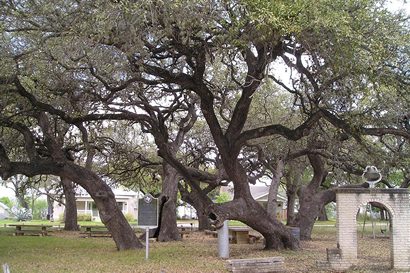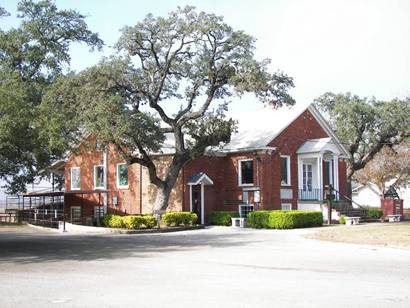Staples, Texas and Camp Clark. (original) (raw)

History in a Pecan Shell
Settlement began in the early 1850s. During the Civil War a Confederate training post (Camp Edward Clark) was in operation here. In 1867 a water-powered cotton gin was set up which later served as a grist mill and sawmill.
Col. John Douglas Staples established a store here in 1871 and in 1879, a post office was granted. The community was named Staples Store until 1891, when the word �store� was discarded. In 1890 the Staples Water Power Company began construction of a wooden water tower. From a population of about 40 residents in the mid 1880s, Staples grew to 125 residents by 1892. Four years later it had risen to 150. In 1896 the community had 150 people and its own cemetery In 1913 both a new schoolhouse and a new metal water tower were completed.
The Handbook of Texas in their town history of Staples tells of the goring of Mrs. Tom Anderson by her cow. The woman, who was forty-nine when the unfortunate incident took place in 1912, was totally disemboweled. She was taken to the doctor who cleaned the wound with tap water, rearranged her entrails, stitched her up, and told her family to get her affairs in order. �Granny� Anderson outlived her doctor by 20 years and died at the age of 105 in 1968.
Staples� elementary school merged with San Marcos in 1949. The 1993 population of 75 has increased to 350 for the 2000 Census.
Staples, Texas Landmarks



Camp Clark Historical Marker
On Hwy 621, Staples city park
Photo courtesy Sarah Reveley, October 2007
Historical Marker
Camp Clark, C.S.A.
Named for Edward Clark, first Confederate Governor of Texas, whose Executive Order June 8, 1861, created voluntary camps of instruction such as this. Food, camp facilities and guns were voluntary gifts by local people. Farmers, merchants, artisans, laborers gave goods and services. Men with military training and experience gave their time as drillmasters.
This and 50 or 60 other camps of instruction mainly taught walking to Texans brought up with the habit of moving about on horseback. (6 out of 10 Texans joined the Cavalry. Governor Clark felt compelled to say in his Executive Order that infantry service was actually a matter of honor.)
Operated despite scorn of 18 to 35 year old recruits who had fought Indians most of their lives and were impatient for battle-- not for training.
Though neither Texas nor the Confederacy in 1861 had funds for camps of instruction, by 1862 privates were paid 11amonth,officers11 a month, officers 11amonth,officers50.
This Guadalupe County camp of instruction was convenient to roads and to water. Area units that trained here included Co. D, 4th Texas Infantry, of Hood's famous Texas Brigade, and 4th Texas Cavalry (Partisan) under Captain William P. Hardeman.

Texas Escapes, in its purpose to preserve historic, endangered and vanishing Texas, asks that anyone wishing to share their local history and vintage/historic photos, please contact us.
